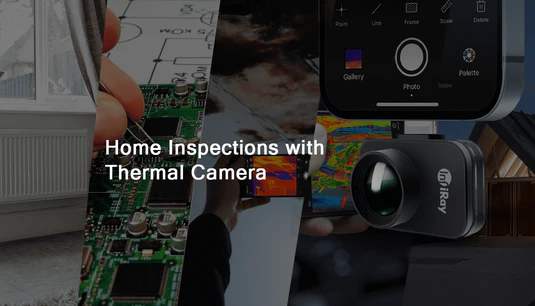

Thermal Camera For Sale
0产品抱歉,此系列中没有产品
欢迎来到Xinfraredx,您热成像产品的首选目的地。无论您是热衷的爱好者、需要精密工具的专业人士,还是寻求企业解决方案的商家,我们都能满足您的需求。Xinfraredx提供最新的热成像相机、配件、软件以及全面的维修和更换零件,成为您质量和可靠性的一站式购物中心。
热像仪介绍
A 热成像相机,也被称为一个 红外相机 或 热成像相机,是一种基于物体发出的红外辐射捕捉图像的设备。与捕捉可见光的传统相机不同,热成像相机能够检测热量并创建温度变化的视觉表示。这种能力使它们在能见度受限或需要监测温度变化的情况下变得不可或缺。
消费级、专业级和企业级热像仪
面向消费者
沉浸在我们消费级相机系列的迷人热成像世界中。该 Infiray P2 PRO 提供无与伦比的便携性和质量,非常适合轻松捕捉热成像和视频。它成为了探索红外成像世界的爱好者的首选。提供微距和非微距版本。
为专业人士
提供精确、可靠和先进成像选项的热成像相机对专业人士来说是不可或缺的。该 Infiray T2S Plus 提升热成像摄影和摄像,提供卓越的图像质量和性能。非常适合检查PCB和电子元件。还提供工作台等配件。
以上所有型号均可用于企业采购。
热成像软件
为了补充我们丰富的硬件选择,Xinfraredx 还提供尖端的软件解决方案,旨在优化您的成像和数据分析工作。从复杂的数据捕获和分析工具到先进的后期数据处理能力,我们的软件系列在各种应用中提升了效率和生产力。我们有支持手机和电脑的软件。您可以在我们的 下载中心.
热像仪是如何工作的?
热成像相机通过使用传感器来检测红外辐射。每个温度高于绝对零度的物体都会发出红外辐射,这种辐射对人眼是不可见的,但可以被热成像相机的传感器检测到。这些传感器通常由氧化钒或非晶硅等材料制成,将红外辐射转换为电信号。相机随后处理这些信号以生成热图,显示温度差异的可视化图。
热成像相机的关键组件
理解 热像仪的关键组件 可以帮助您理解它们的功能:
- 镜头: 将红外辐射聚焦到传感器上。
- 探测器:捕捉红外辐射并将其转换为电信号。
- 处理器:将电信号转换为数字图像。
-
显示: 显示热图,通常使用不同的颜色来表示不同的温度。
热像仪的类型
有几种类型的热成像相机,每种相机都是为特定应用而设计的:
- 手持热像仪便携且多功能,用于检查和故障排除。
- 安装式热像仪:固定在一个地方以进行持续监控,通常用于安全和工业环境。
- 无人机安装的热成像相机:附加在无人机上进行空中检查,在农业和灾害管理中具有益处。
- 智能手机热像仪:紧凑型设备,可连接到智能手机,使热成像技术更广泛地可供大众使用。
智能手机热像仪
智能手机热像仪是紧凑型设备,可以附加到智能手机上,将其转变为强大的热成像工具。这些相机利用手机的处理能力和显示屏,使热成像变得更加便捷和可携带。这些相机在多种应用中都非常有用,包括家庭检查、户外冒险,甚至一些专业用途。在手机上可视化热模式提供了一种方便的方法来检测问题,例如热泄漏、电气问题和绝缘缺口。
热成像单筒望远镜
热成像单筒望远镜是一种手持设备,用于从远处探测热信号。与附加在智能手机上的热成像相机不同,单筒望远镜是专门为热成像设计的独立设备。它们在户外和战术环境中尤其有用,即使在完全黑暗中也能提供清晰的热成像。非常适合用于野生动物观察、安全和搜救行动等应用。这些设备因其便携性、易用性以及快速准确地探测热源的能力而受到重视。
热像仪的应用
热成像相机广泛应用于多个领域,包括:
- 安全与监控:通过热信号检测入侵者,即使在完全黑暗中。
- 医疗保健:通过检测异常温度模式来诊断发热或炎症等情况。
- 建筑检查:识别热泄漏、绝缘问题和水损害。
- 电气检查: 发现过热组件以防止故障。
- 汽车行业:检测发动机和排气系统中的问题。
- 消防:在烟雾弥漫的环境中定位人员并检测热点。
- 环境监测:研究野生动物并监测环境变化。
使用热像仪的优势
热成像相机提供多种 优势:
- 非侵入性:可以在不接触的情况下检测问题。
- 多功能性:适用于众多行业和场景。
- 增强可见性:透过烟雾、雾气和黑暗。
- 预防性维护: 在问题变成重大问题之前识别它们。
- 安全: 提高危险环境中的安全性。
选择合适的热像仪
选择热像仪时,请考虑以下因素:
- 分辨率: 更高的分辨率提供更多细节。
- 温度范围:确保它覆盖您应用所需的温度范围。
- 灵敏度: 更高的灵敏度可以检测到更小的温度差异。
- 镜头选项: 不同镜头满足各种视野需求。
- 便携性:根据您的需求选择手持式或固定式。
热成像技术的未来趋势
热成像技术的未来看起来很有前景,旨在提高分辨率、灵敏度和可负担性的进展。新兴趋势包括:
- 人工智能集成: 增强的图像处理和异常检测。
- 微型化: 更小、更便携的设备。
- 增强连接性: 更好地与其他技术和系统集成。
- 改善无障碍性:更广泛的可负担得起的热成像解决方案的可用性。
使用热像仪的实用技巧
要充分利用您的热成像相机,请遵循以下几点 实用技巧:
- 定期校准:确保您的相机经过校准,以获得准确的读数。
- 了解环境:注意可能影响读数的环境因素,例如反射表面。
- 适当的训练:投资培训以准确解读热成像图像。或者观看Youtube上的相关视频。
- 维护定期维护和清洁您的相机,以获得最佳性能。
Xinfraredx
致力于在热成像行业提供最优质的产品、服务和支持,Xinfraredx 邀请您探索我们广泛的产品系列。让我们助力您自信地捕捉未见的世界。
